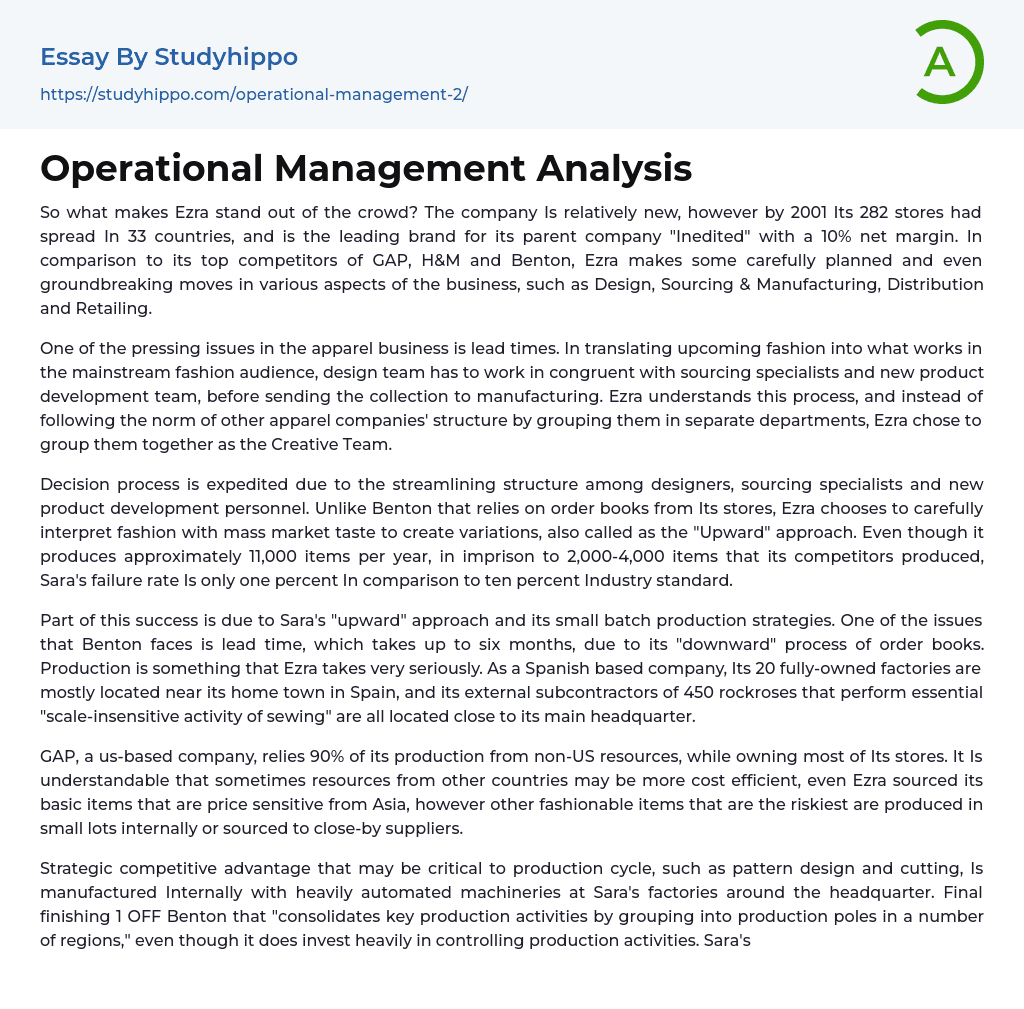Ezra is a relatively new company that has quickly expanded to 282 stores in 33 countries and is the leading brand for its parent company, "Inedited," with a 10% net margin. Compared to competitors such as GAP, H&M, and Benton, Ezra stands out with carefully planned and groundbreaking moves in areas such as Design, Sourcing & Manufacturing, Distribution, and Retailing. One such move is grouping the design team with sourcing specialists and new product development personnel into the Creative Team. This streamlining structure allows for faster decision-making and helps translate upcoming fashion into mainstream fashion that appeals to the masses. Ezra also differs from Benton by creating variations through carefully interpreting fashion with mass-market tastes, known as the "Upward" approach, instead of relying on order books from its stores.
Sara's produc
...es around 11,000 items annually, surpassing its competitors who produce only 2,000 to 4,000 items. However, unlike its competitors, Sara's has a low failure rate of one percent compared to the industry standard of ten percent. One key to its success is Sara's "upward" approach and small batch production strategies. In contrast, Benton faces lead time issues due to its "downward" process of order books. Production is vital for Ezra, a Spanish company, and it takes it seriously. It has 20 fully-owned factories mostly located near its home town and 450 subcontractors for sewing, all located close to the headquarters. GAP, a US-based company, relies on non-US resources for 90% of its production but owns most of its stores. Although Ezra sources basic items from Asia due to price sensitivity, it produces other fashionable and high-risk items internally or sources them to nearby suppliers.
Sara's has a strategic competitive advantage in the production cycle with its internal manufacture of pattern design and cutting using heavily automated machinery at its factories around the headquarters.Benton consolidates key production activities by grouping them into production poles in various regions, while also investing heavily in controlling production activities. Sara's distribution is centralized at one main distribution center, with a satellite center being built in Madrid. On the other hand, H builds a distribution center in each country of distribution despite sourcing all of its production. However, their lead times are still relatively short. Ezra adopts a just-in-time production process with no warehouse or distribution center that holds inventory for longer than 3 days to reduce stock holding costs. This approach is integrated into Sara's marketing strategy of "scarcity," which aims to produce collections in small batches to reduce the potential of the bullwhip effect. The company's store managers are incentivized to detect unpopular items and send them back to the distribution center to be sent to close-out stores nearby, resulting in a failure rate of only 1%.
Ezra achieves 15-20% of its sales at discounted prices, but uses empty shelves to display full-priced popular items. The key to Sara's success is the freshness of their offerings due to high turnover, scarcity resulting from small shipments, and the strategic location of their stores. Ezra changes its merchandise constantly, with 75% being replaced every three to four weeks. Benton struggles and narrows its product line while Sara rapidly updates and refreshes their stores, resulting in customers visiting an average of 17 times a year compared to competitors' three to four. Both Ezra and competitors establish
partnerships, such as joint ventures and licensing, in other countries. Benton is known for licensing retail to small third-party stores globally while Ezra uses franchising in smaller, riskier countries and joint ventures in larger markets with barriers to direct entry.
Regardless of the approach utilized, Ezra will maintain management control and retain the ability to establish "own stores" in the mentioned markets. The standout feature of Ezra lies in its significant degree of vertical integration, which, along with the company's vigilant product quality monitoring and meticulous analysis of International markets, contributes to its ten percent net margin. However, as production capacity and International distribution channels expand, Ezra may need to scrutinize its centralization-oriented process to identify any potential bottlenecks.
- Chief Executive Officer essays
- Convenience Store essays
- Firm essays
- Training And Development essays
- Unilever essays
- Variable Cost essays
- Virgin Group essays
- Bargaining essays
- Entity essays
- Pest analysis essays
- John Locke essays
- 9/11 essays
- A Good Teacher essays
- A Healthy Diet essays
- A Modest Proposal essays
- A&P essays
- Academic Achievement essays
- Achievement essays
- Achieving goals essays
- Admission essays
- Advantages And Disadvantages Of Internet essays
- Alcoholic drinks essays
- Ammonia essays
- Analytical essays
- Ancient Olympic Games essays
- APA essays
- Arabian Peninsula essays
- Argument essays
- Argumentative essays
- Art essays
- Atlantic Ocean essays
- Auto-ethnography essays
- Autobiography essays
- Ballad essays
- Batman essays
- Binge Eating essays
- Black Power Movement essays
- Blogger essays
- Body Mass Index essays
- Book I Want a Wife essays
- Boycott essays
- Breastfeeding essays
- Bulimia Nervosa essays
- Business essays
- Business Process essays
- Canterbury essays
- Carbonate essays
- Catalina de Erauso essays
- Cause and Effect essays
- Cesar Chavez essays




